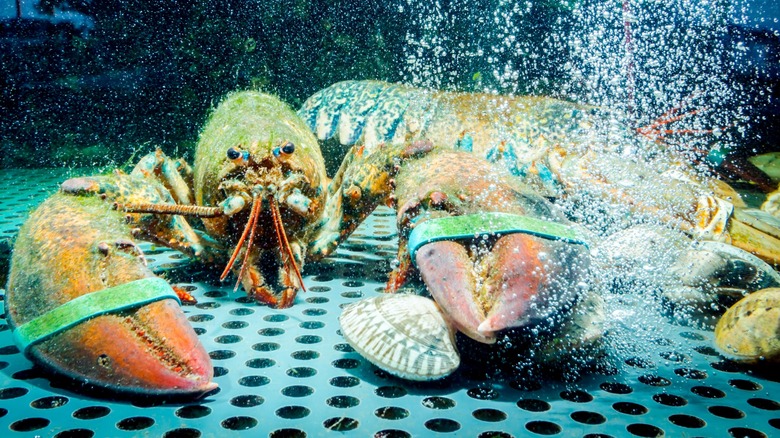The Lobsters In Your Grocery Store Tank Aren't As Fresh As You Think
Have you ever walked by the seafood/butcher section of your local grocery store and beheld its dark (and often odorous) tank of live lobsters? It's something we see less and less of these days, but live lobster tanks do indeed persist. In all honesty, if you're thinking about buying one of these lonely-looking crustaceans, you may want to think again. These tank lobsters are often neglected and stressed, and this isn't just sad: They also don't taste very good.
The key to getting good seafood is regionalism. If you live in a coastal place, you're far more likely to find fresh lobster. But if you're closer to the cornfields of the Midwest and pretty far from the ocean, you may want to skip the grocery store lobster tank, where live lobsters may have been sitting for weeks. However, this doesn't mean that you can't still get your hands on fresh lobster. You'll just need to get it by other means — which is entirely preferable to buying a lobster from the dubious-looking aquarium poised at the far end of your supermarket.
There is a lot of conflicting information about lobster storage
If you know a thing or two about the different lobster varieties, you're probably also aware that there's science behind why you shouldn't freeze live lobsters. But it might not be for the reasons you've heard — such as lobsters having some magical (and toxic) hormonal meltdown within their carapace immediately upon dying. If you need to, you can store live lobsters in the fridge for about 24-ish hours but never in the freezer or the meat becomes mushy, unpalatable, and hard to work with.
It's true that they do spoil quite quickly, but the idea that you must keep a lobster alive right up until the very moment of cooking is widely debated — and, honestly, a bit ghoulish. The confusion about live lobster handling and concerns about rapid spoiling are (of course) where the origins of the grocery store tank lie, something along the lines of it's imperative to preserve the life of the lobster to preserve the life of the customer.
Not only is this not entirely true, but some of the conditions lobsters are being maintained in could prove to be less than savory for their potential consumer. Algae, mold, physical mutilation — all of these things make for a pretty sad lobster, both in spirit and in flavor. But if you don't live on the coast of Maine, don't fret. There are online lobster sources that will ship you live lobsters in just about every corner of the country. Services like LobsterAnywhere are a great resource for locating and purchasing fresh lobster.
The meat from tank lobsters is often subpar
These grocery store lobster tanks have stirred quite a bit of controversy, and, in recent years, have even prompted an online petition banning the practice of keeping live lobsters in commercial spaces altogether. Lobsters are kept unfed and in cold temperatures to slow their metabolisms, but this half-cryogenic hellscape doesn't optimize the freshness or quality of these crustaceans in the slightest. In fact, the inevitable atrophy that comes with lobsters being held in captivity — sometimes for several weeks — actually degrades their meat and makes it shrink.
In the fishing industry, these sluggish lobsters are known as "sleepers," and they should be devoutly avoided. Speaking plainly, have you ever seen a grocery store tank lobster that looked anything but halfway to lobster heaven? Probably not. The solution for your lobster cravings is either to travel to somewhere they live (we mean, have you tasted Maine lobster?) or have them directly delivered to you via express mail. The bottom line is that happy lobsters taste better, and there are no happy supermarket lobsters. Forewarned is forearmed.


